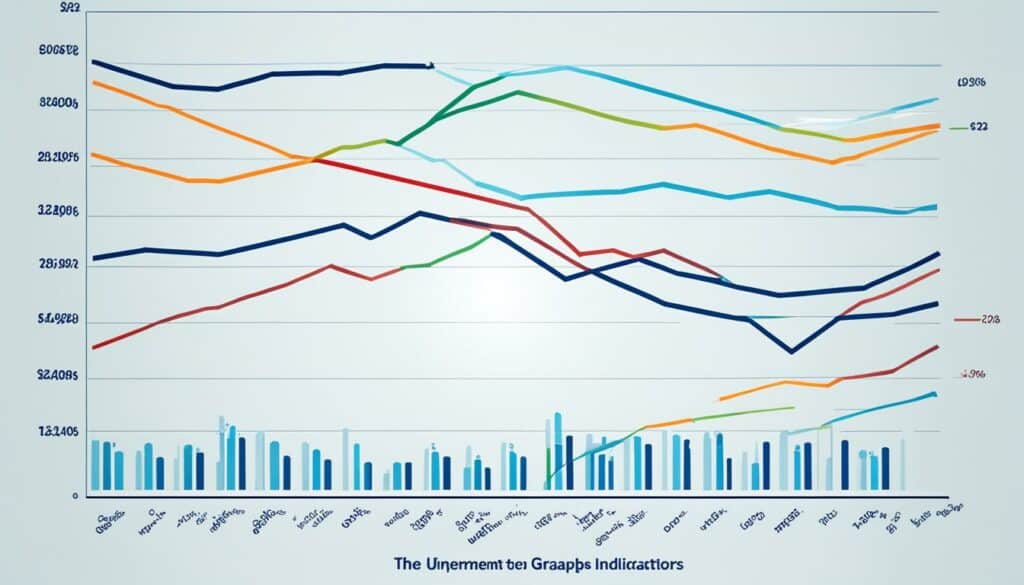Menu

Only 43% of companies use heat maps and session recording tools, even though 48% say they work well. This shows a big chance for businesses to boost their market analysis. Using these tools leads to smarter decisions based on accurate data about industry and market trends.
Understanding market performance is key to knowing financial trends and stock markets. It helps companies predict what consumers will do, see patterns in the industry, and know future trends. This information is vital for making plans and forecasts.
Market analysis goes beyond just finance. It also helps companies understand their customers better and create strong marketing. By regularly checking on the success of marketing efforts, firms can adjust their strategies to meet customer needs better. This leads to continued success.
Market trend analysis is key in market research. It shows how well a business is doing. It also points out strong and weak areas. This kind of analysis helps in making smart decisions about what products to make better or new ones to create.
Market trend analysis looks at market and customer behaviour. It helps us see what trends are big over a set time. This is vital for businesses. It lets them plan and change as needed. This way, they can avoid problems in the future.
The analysis has many steps:
Acuity Knowledge Partners has special tools for this kind of analysis. They use online surveys and create custom dashboards for real-time tracking. These tools help businesses make better choices, beat their rivals, and please customers by using the latest data.
By using certain strategies and tools, analysis can guide smart investment choices. This way, businesses can cut down on risks, make better choices, and manage their assets well. It’s all about reading economic signs and patterns right.
Trend analysis looks at past data to spot chances to buy or sell. It focuses on the quality and the right reading of data. But, watching and reviewing trends often is key to staying up to date.
By keeping an eye on what customers like, their habits, and new tech, businesses can adjust their plans faster. This keeps them in line with the economy’s movements. It guides big decisions on things like prices, what to stock, and where to expand.
Using the insights from analysis, businesses can be ready for what’s next. It helps them succeed in a changing market with confidence.
Market trend analysis is key for seeing a market performance clearly and building a strong business strategy. It shows where the market is going. This helps businesses find new chances and stay away from risks. It shows what companies do well and where they need to improve.

To study trends, experts use market reports, news, what rivals do, customer surveys, and data from social media and websites. This gives a broad look at consumer behaviour trends. By checking this data with stats and methods, businesses find hidden insights. They can see patterns, links, and surprises in the information.
Spotting big trends helps businesses change their plans to do better in the market. It’s important to keep an eye on rivals while checking market trends. This way, companies can find unique spots in the market and stand out.
Adjusting strategies from ongoing market trend study boosts product quality, customer happiness, and marketing effectiveness. This leads to getting more customers. To stay ahead, businesses should always be checking and changing their strategies. They should think about what needs to happen soon, in the middle, and further in the future.
| Trend Type | Description | Strategy |
|---|---|---|
| Upward Trend (Bull Market) | Prices are rising, signifying positive market performance. | Invest in growth-oriented assets. |
| Downward Trend (Bear Market) | Prices are falling, indicating negative market performance. | Focus on cost-cutting and risk mitigation. |
| Sideways Trend (Rangebound Market) | Prices are stable without significant movements. | Employ a balanced investment strategy. |
Trend trading looks at things like moving averages and lines on charts to make money from trends. It helps in spotting good times to buy or sell stocks. This cuts risks, sharpens decision-making, and makes portfolios perform better.
But, looking at market trends can have its downsides. It depends a lot on how good the data is and on looking at the past. Predicting the future can be hard, and the numbers might not always be clear. Some say that the market is so smart that all the known info is already included, making the past less helpful.
In real life, an investor could use financial data, market trends, and math to guess how a company’s stock might do. Doing this regularly can give a company a real competitive advantage. It helps them understand the market and make smart moves.
For companies wanting to use data for decision-making, learning how to analyse market trends is key. This process uses different tools and methods. They help spot and understand patterns that might affect a business’ plan.
Starting market trend analysis right involves careful data collection and review. Let’s look at the main steps:
There are several methods and tools that can help in making decisions based on data. Here are some that businesses often use:
By following these steps and using the right tools, companies can analyse market trends well. This helps in making smart, strategic choices that are supported by data.
It’s key for businesses to understand different market trend analyses. This knowledge helps them fit their plans with current and upcoming market changes. Using tools like trend analysis means making choices based on data. This keeps businesses moving forward. Now, we’ll look at some standard types of market trend analyses used by businesses.
Consumer trend analysis aims to spot what customers like, how they act, and how satisfied they are. This info is key in aiming marketing towards right target groups and in improving customer happiness. It lets companies adjust their products to meet what customers want. This earns customer loyalty and brings them back for more.
Historical trends analysis looks at past data to find patterns and guess future changes. It’s crucial for setting up coming plans. By revealing short and long-term market trends, businesses can spot if the market is going up (bull markets) or down (bear markets). This helps with planning and staying safe from risks.
Seasonal and temporal trend analysis studies market movements linked to certain times, like holidays. This type of analysis helps firms guess and meet seasonal spikes in demand. It helps them make smarter choices about what to sell when. This boosts profits and keeps customers interested during busy times.

Geographic analysis looks at market trends in different places. It gives insights into worldwide market research. This study lets businesses see how their market looks globally. They can then adapt their strategies to match each place’s tastes and rules. This helps make a strong, global strategy that works well everywhere.
By using a mix of market trend analyses, businesses can get smarter, draw in more customers, and succeed in worldwide competition.
It’s crucial to follow economic trends using financial market indicators. These include GDP growth and inflation rates. They help companies understand consumer patterns and market changes.
Economic indicators are key in market analysis. They let businesses see changes in market demand. For example, high GDP growth means the market may grow. Inflation impacts prices and what people can buy.
A good industry analysis looks at all these indicators for a full market view. By watching GDP and consumer habits, companies can make their products better. This meets the changing needs of buyers.
Also, studying competitors can uncover chances to do better. Looking at economic indicators over time finds trends. This guides future business plans, making market forecasts accurate.
Technological advances are changing financial markets hugely. New technologies and AI have altered how financial companies work. They bring new chances and problems.

New tech is changing the finance world a lot. Now, newbies can make clever investments with auto-tools. Plus, more low-cost online brokers mean more people can join in. Using smart data means we focus on the right information. This has made data more available, changing how markets and people work together.
Between 2004 and 2017, China noticed tech finance helps the economy in the east a lot. By early 2020, Chinese tech firms’ loan balance hit 4.1 trillion Yuan. This was a big jump from early 2018, showing a 38.9% increase.
AI and automation play a big role in finance analysis. They bring new chances, but also need more complex handling. Big investment companies are turning to these techs to run more automated, smart plans in investing.
Recently, China was big on investing in R&D, with 2.43931 trillion Yuan put in by 2020. The number of patents has also shot up, hitting 2.213 million by late 2020.
| Statistic | Value | Year |
|---|---|---|
| Growth in Loan Balance of Tech Enterprises | 38.9% | 2020 vs. 2018 |
| Investment in Scientific Research | 2.43931 trillion Yuan (55.6% Increase) | 2020 vs. 2016 |
| Effective Invention Patents in China | 2.213 million (Double from 2016) | 2020 |
| High-Tech Product Export Growth | 733.4 Billion USD (49% Increase) | 2020 vs. 2010 |
| Technology Market Business Volume | 2.8252 trillion Yuan (Six-fold Increase) | 2020 |
| High-Tech Manufacturing Proportion | 15.1% (Increase from 9.4%) | 2020 vs. 2012 |
| China’s Contribution Ratio of Technological Advances | 60% (From 43.2%) | 2020 vs. 2005 |
In summary, finance is really taking on these new techs. It’s a big shift, making the market better and more innovative.
It’s vital to understand and keep an eye on important market metrics to succeed in business. These numbers give us valuable info for making smart decisions and improving our strategies. Let’s look into sales volumes, profit margins, and the feedback we get from customers.
Looking at how much we sell is key to knowing where our products stand in the market. We see how well we’ve reached customers and what they want by studying sales. It also helps us spot trends and adjust our marketing plans. If sales are changing, it might mean we need to react to new customer interests fast.
Examining our profits tells us a lot about our financial situation. Profit margins show how well we’re managing our costs and if our prices work for us. Checking this regularly finds ways to save money and improve our prices for more profit. Ignoring our profit margins could mean less success and bad choices in our plans.
Listening to what customers say is crucial for making our products and services better. It lets us see if they’re happy and what we can do to improve. Tools like Net Promoter Score (NPS) and seeing how many customers we keep help us understand loyalty. Getting feedback often helps us focus on what customers really want, making us better than our competitors.
| Metric | Purpose | Importance |
|---|---|---|
| Sales Volume Assessment | Tracks the number of units sold | Indicates market demand and product viability |
| Profit Analysis | Measures profitability and financial health | Ensures operational efficiency and guides pricing strategies |
| Customer Feedback | Collects consumer opinions and satisfaction levels | Drives product improvement and customer loyalty |
These metrics offer a complete look at how well a business is doing in the market. Using data from sales, profits, and customer views helps us make choices that fit the market and what customers want. This leads to being better than others in the market.
Studying economic indicators thoroughly is key for businesses that want to grow. It helps companies understand the market better. This way, they can make smart decisions. By checking economic factors, a business can plan how to grow well. They can decide the best prices, when to enter new markets, and how to manage products. This fits with what they expect from the economic forecast.

Several important indicators are looked at for market analysis for growth. Leading indicators, such as the yield curve and consumer durables, tell about future economies. Coincident indicators like GDP and employment say how the economy is now. And lagging indicators show what’s already happened, like GNP and interest rates.
Stock prices tell a lot. They hint where the economy is going next.
| Indicator Type | Examples | Function |
|---|---|---|
| Leading Indicators | Yield curve, Consumer Durables, Net Business Formations | Predict future economic movements |
| Coincident Indicators | GDP, Employment Levels, Retail Sales | Show real-time economic activity |
| Lagging Indicators | GNP, CPI, Unemployment Rates | Inform about past economic events |
The pros and cons of economic indicators are clear. They are easy to find and often right, if used well. But sometimes, they might miss important details. Yet, if used the right way, they can really help a business grow.
In a fast-changing world, keeping up with tech advances is key. For example, when Blockbuster filed for bankruptcy in 2010 and Netflix grew, we saw why understanding trends is critical. Tools like Google Analytics and IBM Watson help predict changes. This information allows businesses to set smart goals and keep up.
Analysing the competition is vital. It lets businesses see what rivals are doing and where they can improve. By learning from competitors, companies can solve customer problems better. Strong research is the backbone of any good marketing plan.
To take the lead, it’s important to grasp what your competitors are up to. This means studying what products they sell, how much they charge, where they sell them, and how they advertise. Netflix saw the future in streaming, while Blockbuster stuck with DVDs. The result? A big win for Netflix.
| Aspect | Netflix | Blockbuster |
|---|---|---|
| Product | Streaming services, original content | Physical DVD rentals |
| Price | Subscription-based, various tiers | Rental fees, late fee penalties |
| Place | Online platform | Physical stores |
| Promotion | Digital ads, influencer marketing | In-store promotions, print ads |
Turning knowledge about your rivals into action is the next step. By knowing the market and gaps in it, businesses can innovate. They can make new and better products, improve sales, and get closer to customers. This leads to staying ahead in the long run.
In today’s world, social media platforms play a huge role in understanding user needs. Sites like Facebook, Twitter, and TikTok are filled with current data. This data helps in making quick decisions for better competition.

Understanding how people act on these sites is a key part of market analysis. Tools that listen to social media help spot new trends fast. They let businesses join conversations happening online.
Brand perception and consumer feelings are key to market success. By following what people say online, companies can make smarter choices. This keeps them in touch with what people want.
Looking at what people say online also shows how brands are thought of. This info is great because it’s quick and shows what people think now. It beats old-fashioned surveys by giving instant feedback.
By 2024, using AI to customise content will be very important. This means tailoring messages and products just for you. It makes talking to customers more personal and effective.
Video content is very popular on social media. TikTok and YouTube are favourite places for many. They offer short videos and longer ones. Instagram and Facebook are making it easy to shop while browsing too.
By using these trends well, brands can make their marketing more powerful. They can react quickly, talk directly to customers, and offer what people really want.
Learning about product performance is key for any business wanting to do well in competitive markets. It involves looking at detailed performance data and checking the quality of products thoroughly. This gives a deep understanding of how products do through their life stages. It isn’t just a quick check but includes looking at data regularly, making decisions that keep the product’s lifecycle on track.
Performance metrics are like a product’s report card. They tell us how well it’s doing in the market. For instance, we look at things like sales volume, customer feedback, and conversion rates. By digging deeper, we can see detailed information about things like user numbers, website visits, and sales, broken down by platform and user type. This breakdown helps us understand how different groups behave and improves our marketing plans.
| Key Metrics | Web | Landing Page Group |
|---|---|---|
| Users | 120,000 | 45,000 |
| Sessions | 200,000 | 70,000 |
| Orders | 15,000 | 5,500 |
| Acquisitions | 1,500 | 600 |
| Conversion Rates | 7.5% | 7.9% |
Another key part of analysing performance is understanding a product’s lifecycle. This includes looking at how it starts, grows, matures, and then declines. Managing a product’s lifecycle well is important for its success. By checking on its performance at every stage, we make sure the product is the best it can be and still matters in the market.
Breaking down data by devices, where the marketing happens, who’s using the product, and the steps customers take, helps fine-tune the product. For example, detailed analysis can show us how to improve a buyer’s journey from adding to a cart to completing a purchase. This insight can make user experience better, which can increase how engaged users are, proven in studies from mobile games.
To sum up, looking at performance in-depth, from metrics to the product’s whole lifecycle, helps businesses make smarter plans. This approach improves their success both now and in the future.
Understanding what customers like is key in trend analysis. It helps shape product development and marketing plans. By looking at how customers interact, their experiences, and feedback, businesses can boost satisfaction and loyalty.

Analysing consumer trends helps companies spot new chances for growth. They can make marketing that fits each audience’s likes. Looking at past data can show trends, helping businesses make smart moves for the future.
Analysing tech trends finds chances to innovate and keep up. Looking at demographics, such as age and income, helps understand who to target. This leads to better marketing. Checking out what’s hot on social media means companies can connect better with their audiences.
Here’s a peek at the insights trend analysis can offer:
| Type of Trend Analysis | Key Insights | Applications |
|---|---|---|
| Consumer Trend Analysis | Identify new customer preferences and behaviors | Targeted product development and marketing strategies |
| Historical Trends Analysis | Recognize past patterns and predict future trends | Informed decision-making and market positioning |
| Seasonal Trend Analysis | Adjust inventory, pricing, and marketing strategies | Maximizing sales during peak seasons |
| Geographic Trend Analysis | Tailor strategies to regional consumer variations | Effective regional market strategies |
Good trend analysis keeps businesses informed about their markets. By watching trends, companies can see when the market changes. This keeps them ahead and ready for what’s next.
In conclusion, doing strategic market analysis is key for businesses to do well. It involves looking at things like economic signs and what tech is trending. This helps businesses find out what customers want. They can then make plans to do better and get more people interested.
Looking at how well a business is doing needs a detailed look. It means setting clear research goals and asking the right questions. By using different ways to look at data, like stating facts or making guesses, companies can understand more. This avoids mistakes and makes their findings more trustworthy.
Understanding what the data shows comes next. It’s about putting these findings in the bigger picture, without oversimplifying. Good ways to tell others include using clear graphs and simple words. This way, everyone can understand and take action. Also, acting responsibly and keeping people’s private details safe is crucial.
On top of this, entrepreneurs have lots of help available worldwide. Programs like FasterCapital can help with costs. They give advice based on what worked before. This support helps companies stay ahead and plan well for the future.
Market trend analysis looks at data to find market patterns over time. It’s vital for businesses. It helps with planning, forecasts consumer habits, and aids in long-term strategy making. So, it’s key for spotting market trends and how well things are doing.
It checks things like GDP, inflation, and interest rates. Also, it considers how markets grow and behave. This info helps businesses make smart choices and guess future demand changes.
Looking at how the market and consumers act reveals lots. It shows the best and weakest areas and helps in making smart moves. This helps businesses interact better, sell more, and understand the market clearly.
First, you pick the trends that matter. Then, you’d do deep research, using tools for data. After that, you look for patterns and meanings in the findings. Reacting to these trends is also important for success.
There are many tools, like software and ways to show data. Market analysts use them to understand trends better. This helps in making decisions that are based on facts.
These include looking at what consumers like, past trends, and how trends change with the time or place. Each type helps in different parts of making plans.
Economic signs like GDP or interest rates are key to understanding market success. They help plan for what people might buy and where the market might go. So, they shape big decisions businesses make.
New tech and things like AI are changing how markets work. They cut costs and let companies do new things. Tech also helps in facing challenges like the cookie changes online.
Common metrics to watch are how much is sold, profit, and what customers say. These show how well a product is doing. They help set it apart from others and meet what customers want.
Economic signals can help a business grow. By studying them, companies can choose the right prices, control stock, and decide where to sell. This gets firms ready for changes in the economy.
Knowing what competitors are doing is vital for a good market plan. It lets companies see where they can stand out and meet customer needs better. It also helps to understand where they are in the market.
Social media gives great clues on what people like and the current market trends. By following what’s happening on social media, businesses can adjust their ads to match trends. This boosts how much people know and like their brand.
Looking at how products do, using measures such as sales and what people say, is key. It helps manage products over their life well. Plus, it shows where the product stands and how it might do in the future, helping plan ahead.
Figuring out what customers prefer with trend studies helps in two ways. It makes products or marketing better suited to what people want. This increases happiness, loyalty to the brand, and the business’s success.